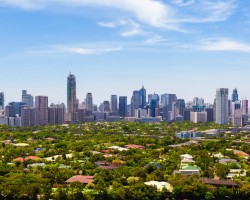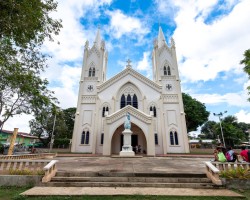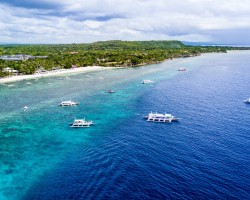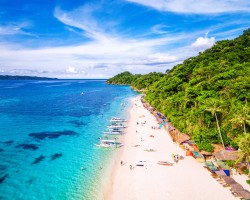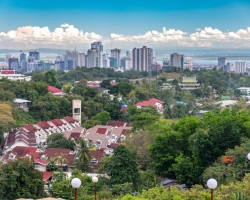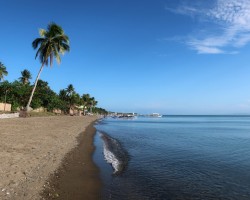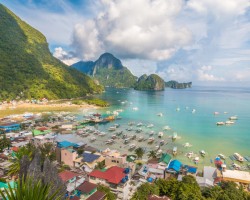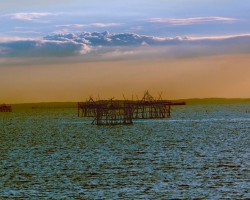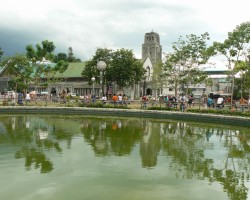Best time to go to the Philippines for a perfect weather and where to go?
When is the best time to go to the Philippines?
The best time to visit the Philippines is between December and April. During this season, rainfall is moderate and there are mostly hot and sunny days. Consequently, this period is also when tourist traffic is highest. Travelers seek to escape the winter cold in Europe and often come to enjoy the year-end festivities under the sun. Prices tend to skyrocket significantly during the months of December and January, which correspond to the peak tourist season in the Philippines.
However, it is entirely possible to travel to the Philippines during the shoulder seasons, for example in November and May. During these periods, visitors can not only benefit from advantageous prices but also from weather conditions that remain very favorable. Furthermore, this period is ideal for underwater diving. Indeed, the sea water temperature remains very pleasant and visibility conditions are excellent.
Lastly, if you are wondering when to visit the Philippines to avoid rain, you should avoid the monsoon season and typhoons. Indeed, during the months of May to October, bad weather is more common.
Where and when to go based on the weather?
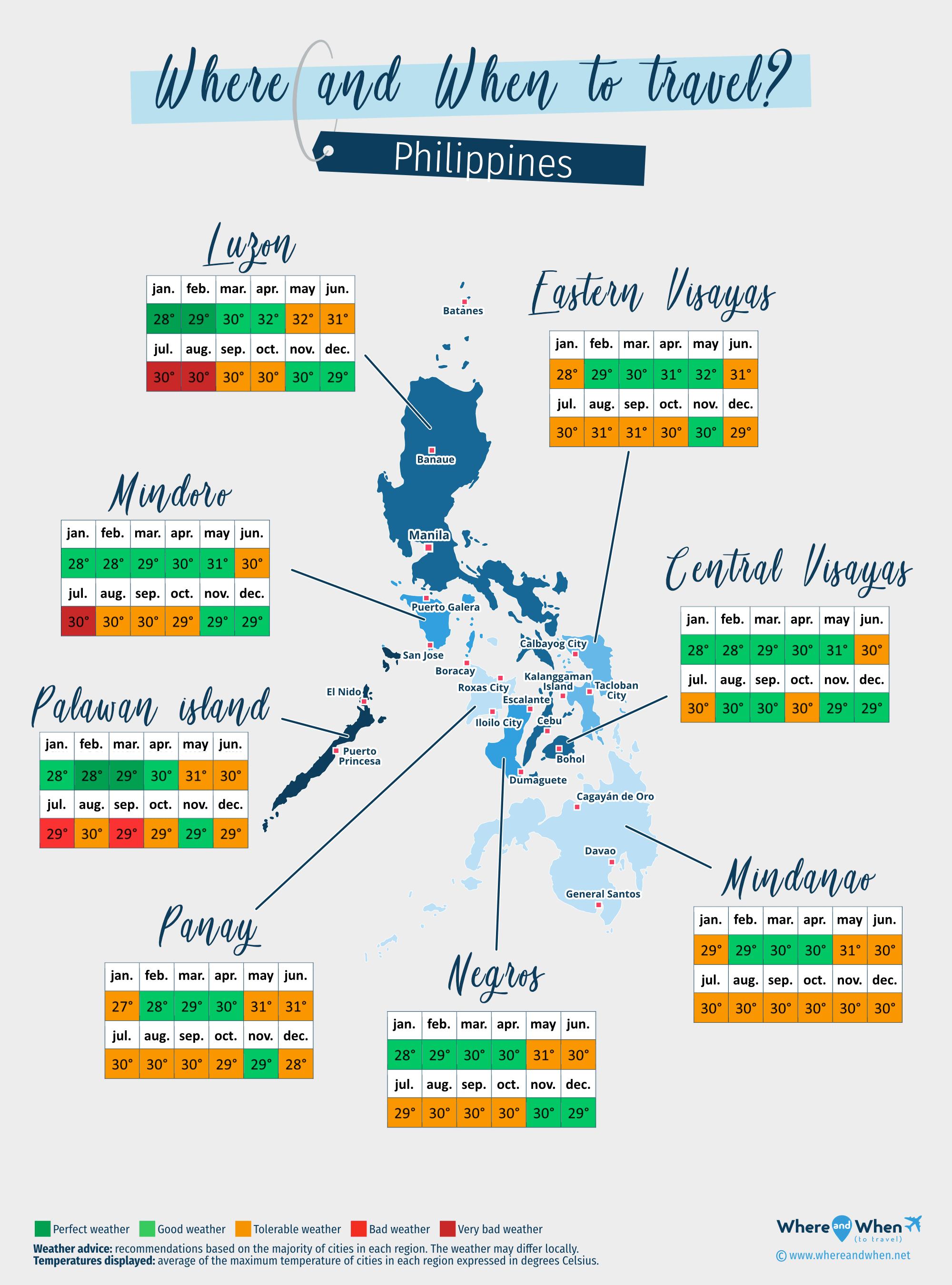
Central Visayas
Cebu, Bohol, Siquijor...
Eastern Visayas
Calbayog City, Tacloban City, Kalanggaman Island...
Luzon
Manila, Batanes, Banaue...
Mindanao
Davao, Cagayán de Oro, General Santos...
Mindoro
Puerto Galera (Mindoro), San Jose (Mindoro), Pinamalayan...
Negros
Dumaguete, Bacolod, Escalante...
Palawan island
Puerto Princesa, El Nido, Coron...
Panay
Boracay, Roxas City, Iloilo City...
To get all the information about the climate and weather in the Philipines for a specific month, click on the corresponding link below:
Philippines in january Philippines in february Philippines in march Philippines in april Philippines in may Philippines in june Philippines in july Philippines in august Philippines in september Philippines in october Philippines in november Philippines in december
Best time to travel to Philippines by cities
Climate and Weather in the Philipines
Paradisiacal archipelago located in the heart of Asia, the Philippines are surrounded by many countries such as Indonesia, Malaysia, and Singapore. Thus, we find there a climate quite similar to other countries in Southeast Asia: hot, humid, and tropical.
The average annual temperatures range between 15 and 34°C (94°F) , with a slight increase from April to June, just before the rainy season.
The Philippines experience a climate dominated by two distinct seasons: the rainy season and the dry season.
Let's take a detailed look at the specifics of the climate in the Philippines during these periods below.
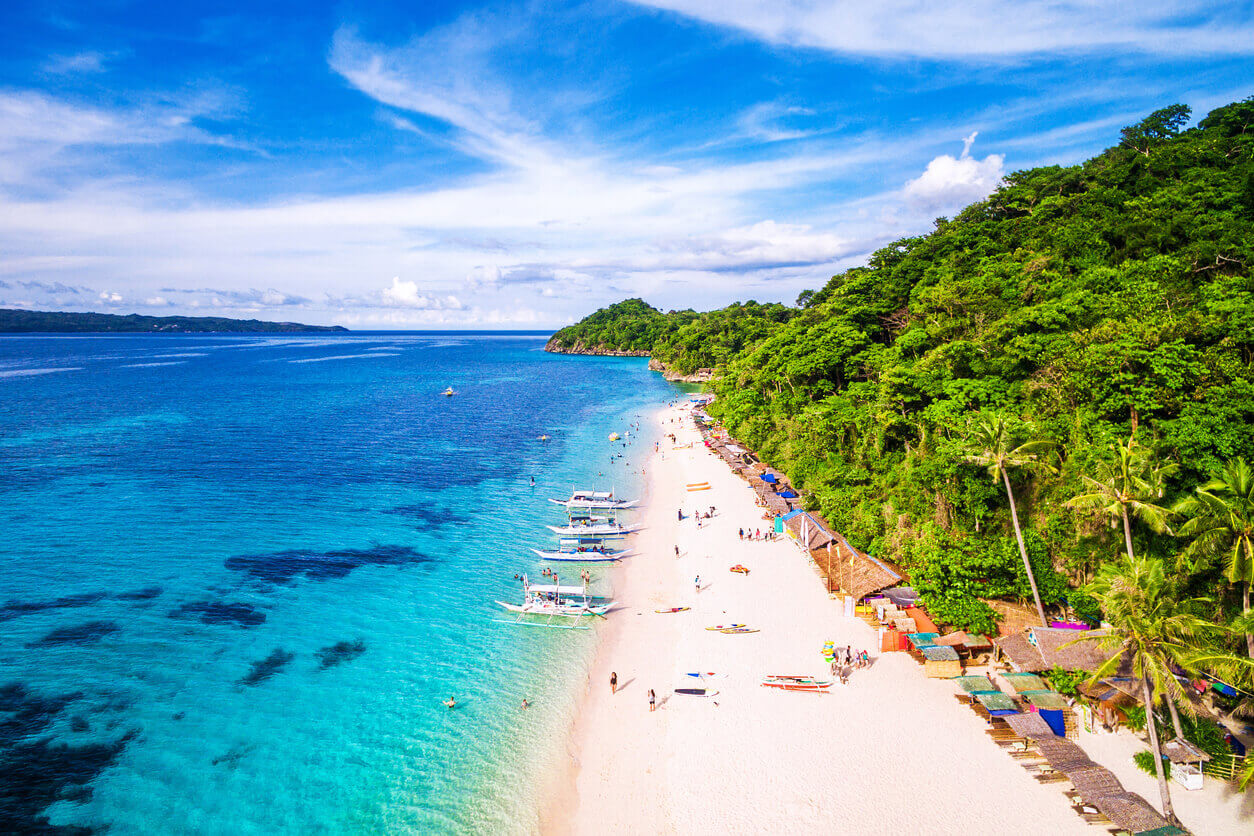
Climate of the Philippines: the rainy season
From May to October, the summer monsoon waters the vast majority of the Philippine archipelago. Consequently, there are particularly abundant rains that fall on the islands almost every day. Depending on the regions, the rainfall during this period ranges from 100 to 800 mm per month. Generally, the months of June to August are the rainiest.
Moreover, during this period, the climate of the Philippines is affected by tropical storms and cyclones. Indeed, the archipelago is located along the path of Asian typhoons. Thus, the cyclone season spans from May to December, with a peak between mid-August and November.
The Philippines are affected by a large number of cyclonic events each year, bringing strong winds and torrential rains for several days. Furthermore, these events are often devastating for the country and its population.
It is worth noting, however, that the interior and west of the archipelago islands are more sheltered. Mountainous reliefs tend to protect certain regions from winds, especially on the island of Mindanao.
Lastly, it should be emphasized that generally during the wet season, rains occur in the form of thunderstorms in the afternoon or at night. This leaves plenty of time to enjoy one's stay. However, in the case of tropical storms and typhoons, heavy rain can persist for several hours in large quantities.
Climate of the Philippines: the dry season
From December to April, the winter monsoon brings fresh and drier air to the Philippines. This results in a sunnier climate and a slight drop in temperatures, ranging from 16 to 32°C (90°F) depending on the time of day and regions. The month of January is often the coolest, although this is relative in the Philippines.
For instance, in Manila and in the northern part of the archipelago, temperatures range from 30 to 34°C (94°F) during this period. However, at night, with the arrival of cool air from the Asian continent, temperatures can drop to around 15°C (59°F) .
The Palawan region experiences constant temperatures of around 32°C (90°F) throughout the year.
Furthermore, in the Visayas region, rains remain significant during this season. The weather is more humid in this area regardless of the time of year. Nevertheless, the months of March and April see less rainfall and are therefore preferable for travel.
Moreover, even during the dry season, air humidity can be challenging in the Philippines, especially in the plains. The atmosphere is often heavy, making outdoor activities less enjoyable.
Lastly, while sea temperatures are higher during the wet season, they remain favorable for swimming during this season, generally ranging between 27 and 29°C (85°F) .
Climate of the Philippines: the transitional season
Between these two seasons, the weather in the Philippines exhibits some peculiarities. Indeed, during the months from April to June, certain areas become particularly hot. Temperatures range from 20 to 36°C (97°F) depending on the time of day.
However, rains are not yet very significant during this period, and the air is less humid than in summer. Thus, this period, between the dry season and the rainy season, is quite ideal for a stay in the Philippines. However, one must be able to tolerate the high temperatures.
Climate of the Philippines by regions
Finally, it should be noted that some areas of the Philippines have an equatorial climate. This means that rainfall is abundant even in winter. This is notably the case in the eastern part of the archipelago, which is more exposed to the wind. For example:
- the west coast of the island of Luzon
- the eastern Visayas archipelago (especially Samar and Leyte)
- the northeast of Mindanao
- the southern islands close to Malaysia
In these areas, precipitation can exceed 2500 mm per year. This is why these zones are relatively sparsely populated (with no major cities) and are relatively less touristy.
Temperatures and rainfall in the Philipines
On these 3 graphs, we present the evolution of temperatures of Philippines and month-by-month rainfall for the cities of Manila, Puerto Princesa, Bohol, Boracay and Cebu, as well as the month-by-month sea temperature for coastal cities.

Peak visitor numbers and tourist seasons in the Philipines
Find out when Philippines has its high tourist season (the period when the influx of tourists is highest) and off-peak tourist season using our data and figures.
Tourist seasons in the Philipines
The months with low numbers of tourists are: January, February, March, April, May, June, July, September, October and November. The number of visitors to Philippines is high in: August and December.
- Very low season in the Philipines: March, May, June, July and September.
- Low season in the Philipines: January, February, April, October and November.
- High season in the Philipines: August.
- Peak season in the Philipines: December.
Figure: Visitor index for Philippines month by month
Average price for flights to the Philippines
A return flight between Melbourne and Manila is generally cheaper if you go in may ($ 507 on average): this is the best time for travellers on a tight budget. In contrast, you may end up paying $ 314 more for your airline ticket to Manila if you go in december.
Where to go in the Philipines?
This table allows you to see the maximum temperature for each city and our opinion on the weather month by month (see colour legend below the table).
| Cities | jan. | feb. | mar. | apr. | may | jun. | jul. | aug. | sep. | oct. | nov. | dec. |
| Manila | 85°F | 88°F | 90°F | 94°F | 95°F | 92°F | 90°F | 88°F | 90°F | 90°F | 88°F | 86°F |
| Puerto Princesa | 85°F | 85°F | 86°F | 88°F | 88°F | 88°F | 86°F | 86°F | 86°F | 86°F | 86°F | 86°F |
| Bohol | 85°F | 85°F | 86°F | 88°F | 90°F | 88°F | 86°F | 88°F | 88°F | 86°F | 86°F | 86°F |
| Boracay | 81°F | 83°F | 83°F | 85°F | 88°F | 86°F | 86°F | 86°F | 86°F | 85°F | 85°F | 83°F |
| Cebu | 85°F | 85°F | 86°F | 88°F | 90°F | 88°F | 88°F | 88°F | 88°F | 88°F | 86°F | 86°F |
| Donsol | 83°F | 85°F | 86°F | 88°F | 90°F | 88°F | 86°F | 86°F | 86°F | 86°F | 86°F | 86°F |
| El Nido | 85°F | 83°F | 85°F | 86°F | 88°F | 88°F | 86°F | 86°F | 86°F | 86°F | 86°F | 85°F |
| Bacolod | 85°F | 86°F | 88°F | 90°F | 92°F | 88°F | 86°F | 86°F | 86°F | 86°F | 88°F | 86°F |
| Banaue | 76°F | 77°F | 81°F | 83°F | 85°F | 85°F | 83°F | 83°F | 83°F | 81°F | 79°F | 77°F |
| Batanes | 76°F | 76°F | 77°F | 81°F | 85°F | 86°F | 86°F | 86°F | 85°F | 83°F | 81°F | 77°F |
| Cagayán de Oro | 85°F | 86°F | 88°F | 88°F | 90°F | 88°F | 88°F | 90°F | 90°F | 88°F | 88°F | 86°F |
| Calbayog City | 83°F | 85°F | 86°F | 88°F | 90°F | 88°F | 86°F | 86°F | 86°F | 86°F | 86°F | 85°F |
| Davao | 86°F | 88°F | 88°F | 90°F | 90°F | 90°F | 88°F | 88°F | 90°F | 90°F | 88°F | 88°F |
| Dumaguete | 83°F | 85°F | 85°F | 86°F | 88°F | 86°F | 86°F | 86°F | 86°F | 86°F | 86°F | 85°F |
| Escalante | 83°F | 83°F | 85°F | 86°F | 88°F | 88°F | 86°F | 88°F | 88°F | 86°F | 86°F | 85°F |
| General Santos | 88°F | 90°F | 90°F | 90°F | 90°F | 88°F | 88°F | 88°F | 88°F | 90°F | 90°F | 90°F |
| Iloilo City | 85°F | 86°F | 88°F | 90°F | 92°F | 88°F | 86°F | 86°F | 86°F | 86°F | 86°F | 86°F |
| Pinamalayan | 81°F | 83°F | 85°F | 86°F | 88°F | 88°F | 88°F | 88°F | 88°F | 86°F | 85°F | 83°F |
| Puerto Galera (Mindoro) | 81°F | 83°F | 85°F | 86°F | 88°F | 88°F | 86°F | 86°F | 86°F | 86°F | 85°F | 83°F |
| Roxas City | 83°F | 83°F | 85°F | 86°F | 88°F | 88°F | 88°F | 88°F | 88°F | 86°F | 85°F | 85°F |
Legend:
perfect weather
good weather
tolerable weather
bad weather
very bad weather
About Philippines
What can I do in the Philipines?
Beaches / swimming
Nature and countryside
Culture and heritage
Sports
Family travel
Crafts / shopping
Gastronomy
Nightlife
Is this weather information for Philippines reliable?
Climate data for Philippines has been gathered every day since January 2009. The analysis of these meteorological data for Philippines allows us to determine the average for each month in Manila, Puerto Princesa, Bohol, Boracay, Cebu, Donsol, El Nido, Bacolod, and 105 other cities.
So yes: this data is reliable except in cases of temporary climate disruption in the region.

